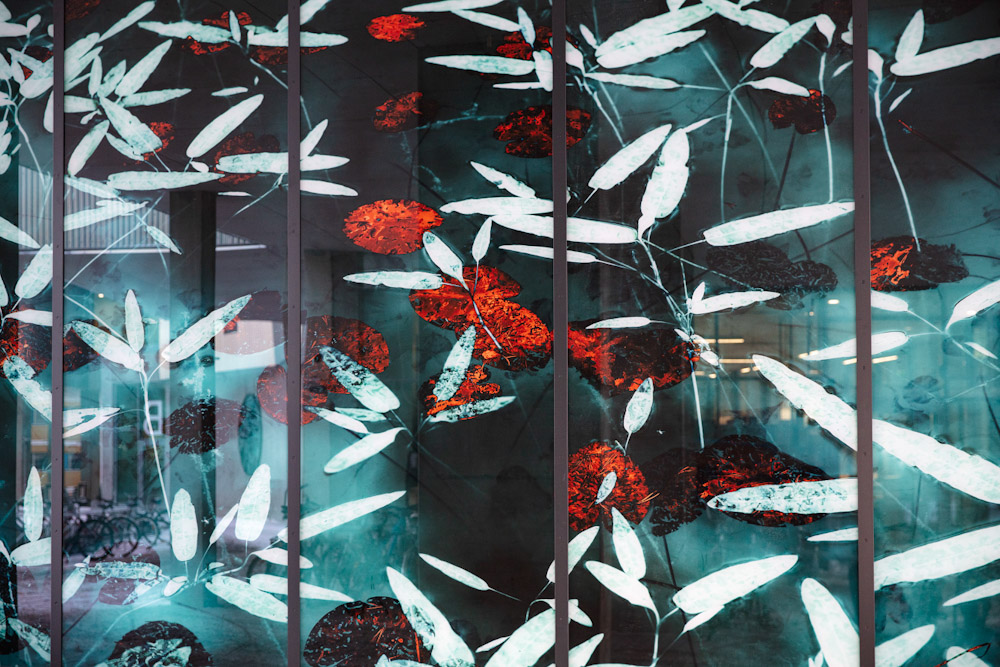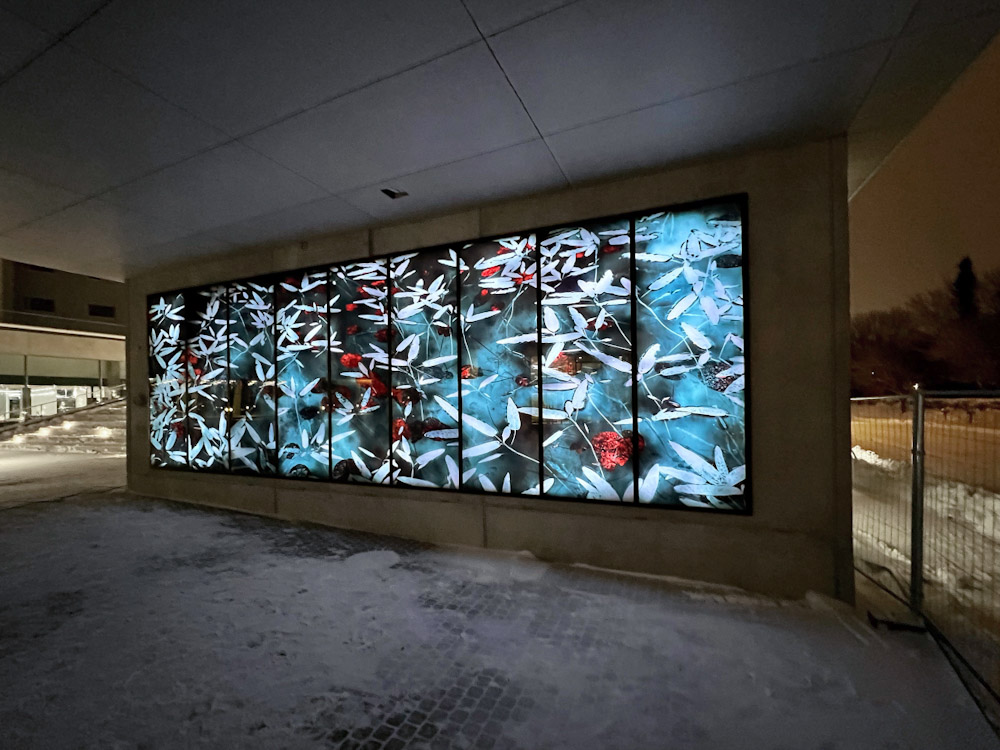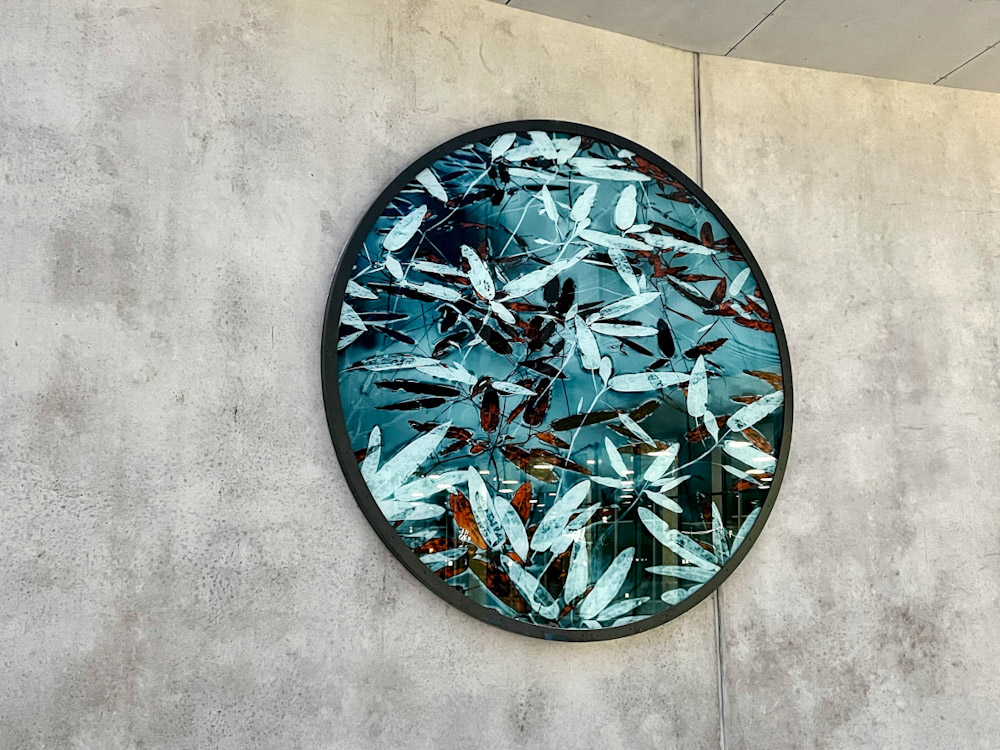
Photographic artist Santeri Tuori's two-part artwork Lumpeet is located in the Tyyssija building of Turku's student village. Water lilies and water plants are depicted in the work. The video-controlled LED light network that lights up in the evenings brings new layers to the work.
Inspiraatio teoksen vesi- ja lummeteemaan syntyi rakennuksen lampea muistuttavasta ovaalista muodosta. Kulku sisäpihalle on kuin sukellus läpi rakenteiden. Samalla sisäpihalla sijaitsevat portaikko ja ylätasanne saavat ajatukseni kulkemaan veden äärellä olemiseen.
Lasilla toteutetussa lummeteoksessani näkyvät paitsi vedenpinnan ja taivaan heijastukset, myös vedenalainen maailma. Teoksen etäännytetty ja salaperäinen tunnelma sopii mielestäni rakennuksen henkeen hyvin. Työn taustalla voi nähdä pitkäaikaisen kiinnostukseni Japaniin ja siellä oleviin kuvataiteen traditioihin.
Teos on kuvattu tätä nimenomaista tilaa ajatellen. Sen koko ja muoto määrittyivät rakennustyömaalla käytyjen vierailun jälkeen. Lasien printtaamiseen käytetyissä keraamisissa väreissä on oma värimaailmansa, joka ei täysin vastaa valokuvauksessa muuten käytettyjä värimaailmoja. Oikean värin, tummuuden ja kontrastin aikaansaamiseksi tarvittiin useita lasille printattuja koepaloja. Niitä käytettiin myös ledien testaamiseen ja ledien oikean tiheyden ja etäisyyden määrittämiseen.


Santeri Tuori
Santeri Tuori (s. 1970) opiskeli valokuvausta Taideteollisessa Korkeakoulussa (nyk. Aalto Yliopisto) sekä oikeustiedettä Helsingin Yliopistossa. Opiskelujen lailla hänen töitään leimaa monialaisuus ja rajojen ylittäminen. Tuori tuli tunnetuksi hänen valokuvaa ja videota yhdistävistä töistään. Töiden aiheet kumpusivat klassisista muotokuvan ja maisemakuvan traditioista. Tuori kuvasi esimerkiksi samoja maisemia Ahvenanmaan saaristoon kuuluvalla Kökarin saarella usean vuoden ajan. Lopullisissa töissä samasta kohdasta kuvatut valo- ja videokuvat yhtyvät. Työt koostuvat useista päällekkäisistä kuvakerroksista, jotka kuultavat toistensa läpi. Teoksissa korostuu niiden tilallisuus ja ajallisuus. Myös äänisuunnittelija Mikko Hynnisen kanssa suunnitellulla äänellä on merkittävä rooli näissä töissä. Valokuva ja videokuva yhdistyvät luoden samalla jotakin uutta, joka ei ole suoraan palautettavissa kumpaakaan.
Nykyisin Tuori on enenevässä määrin työskennellyt myös valokuvan parissa. Hänen valokuvissaankin näkyy kerroksellisuus, ajan monitasoinen läsnäolo sekä vahva yhteys kuvataiteen traditioihin. Tuorin tekemät julkiset taideteokset ovat laajentaneet käsitystämme valokuvasta ja sen käytöstä entisestään. Tuorin töitä on ollut esillä useissa johtavissa museoissa ja gallerioissa niin Suomessa kuin muuallakin. Suomessa häntä edustaa Galerie Anhava.

Todella kiva idea, loistavaa kehityvää taidetta. Suuri hatun nosto TYSsille joka on oivaltanut että tlisllä pinnoilla voi olla näinkin hienoa taidetta!
Hienoa että saatiin taustaa taideteokselle, joka muuten on hieno.